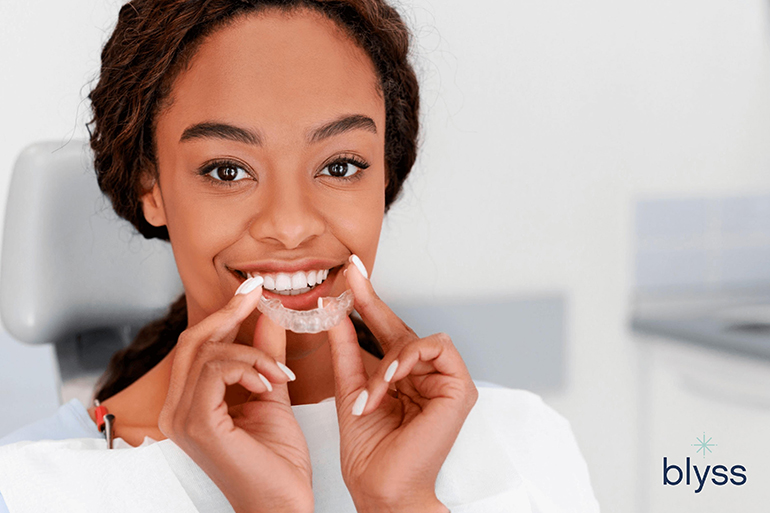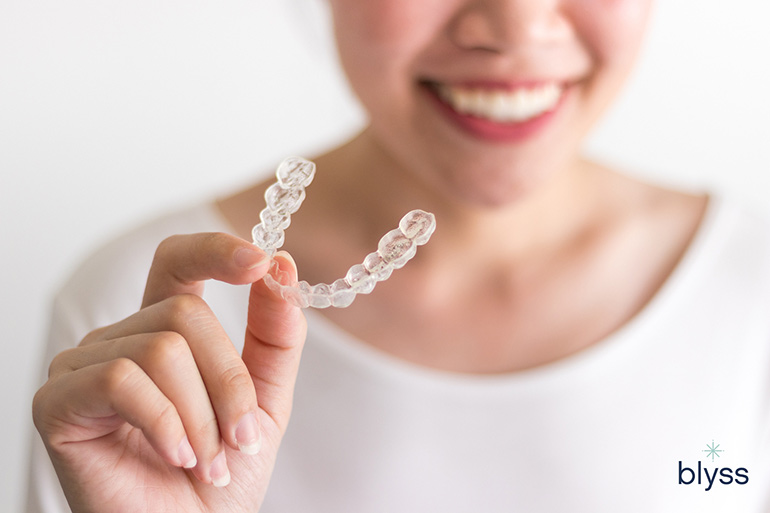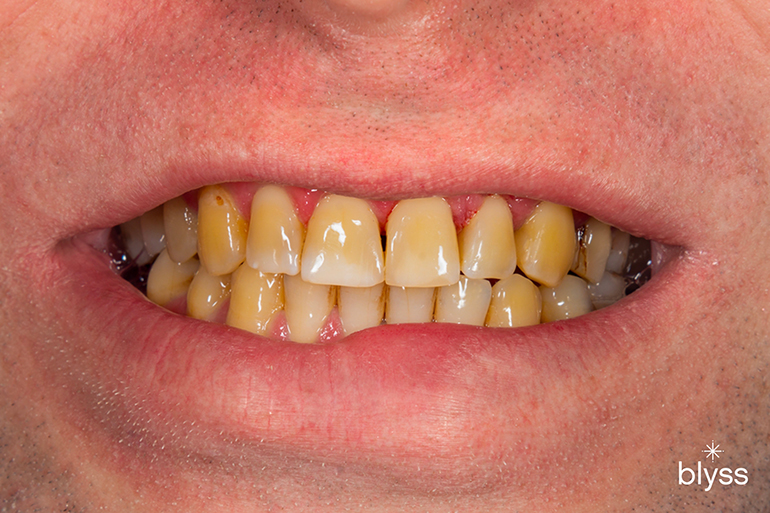Invisalign is a clear alternative to braces that uses removable, nearly invisible aligners to gradually straighten your teeth. Since they’re clear, it can be easy to forget that you’re wearing them and fail to take proper care of them. Remember that your aligners are plastic and it’s important to clean them daily to prevent staining and discoloration. Here’s everything you need to know about how to clean Invisalign so you can keep your smile looking its best.
Related Article: The Invisalign Process Explained
Does it Matter How Your Invisalign is Kept Clean?
Invisalign is one of the most popular orthodontic treatments available today. And it’s no wonder why. Not only is Invisalign practically invisible, but it’s also removable, so you can eat whatever you want and brush and floss your teeth with ease. Plus, no one will even know you’re straightening your teeth! What’s not to love? But one of the drawbacks of Invisalign is that it can be time-consuming or even too daunting to keep clean.
So, does it really matter how you clean them? The simple answer is yes! Although you change your aligners every 2 weeks, it is still essential that you clean them carefully.
Your Invisalign trays are in your mouth for 20-22 hours a day. That gives plenty of time for plaque and bacteria to build up, which can lead to cavities and gum disease. You may not be able to see the build-up on your trays, but that doesn’t mean it’s not there.
If you don’t keep your Invisalign clean, you might notice that they start to yellow or discolor over time. Not only is this unsightly, but it can also be difficult to remove the stains once they’ve set in.
In addition to cavities and gum disease, not cleaning your Invisalign can also lead to bad breath. No one wants that! Plus, let’s be honest – no one wants to wear dirty aligners! Nobody wants to see food particles or stains whenever they smile, so it’s important to keep them as clean as possible.
Invisalign is an investment in your smile – so you want to make sure that you’re taking care of them! By keeping them clean, you can extend their lifespan and get the most out of your treatment.
Related Article: Invisalign In San Diego: Braces For People Who Hate The Idea Of Braces
5 Dos When Cleaning Your Invisalign
But as with anything new, there is a bit of a learning curve. In order to keep your Invisalign clean (and your breath smelling fresh), here are the 5 dos I recommend when it comes to cleaning your Invisalign.
1 – Do Learn How Often to Clean Invisalign
The good news is that you do not have to clean your Invisalign any more than you brush your teeth- ideally, twice a day.
Ideally, you should be cleaning your Invisalign every time you brush your teeth. This means twice a day for most people. If you find that you’re not able to brush your teeth after every meal, then at the very least you should be rinsing your aligners off with water. This will help remove any food particles or debris that may be stuck to them.
To clean your aligners, simply rinse them off with lukewarm water and brush them gently with a soft-bristled toothbrush. Using a coarse-bristle toothbrush may be too harsh on your Invisalign.
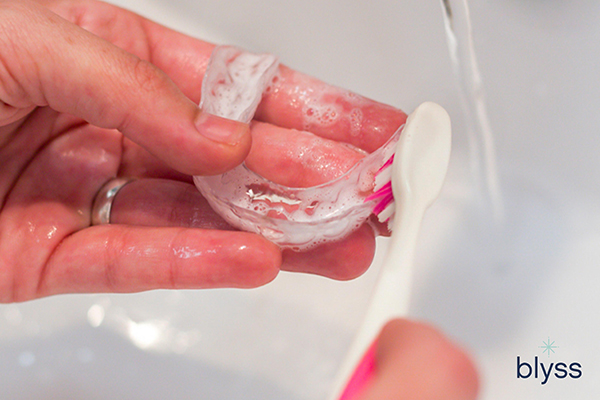
To clean your aligners, use a soft-bristled toothbrush and gentle, clear liquid soap. Be sure to rinse them well after brushing. Make sure not to use the same toothbrush you use for daily teeth cleaning.
Avoid using hot water, as this can cause the aligners to warp. Avoid using toothpaste, as it is abrasive and can leave tiny scratches on the aligners. Once you have brushed them, rinse the aligners thoroughly before putting them back in your mouth.
Make sure to clean your teeth before putting your aligners back in. Plaque and bacteria can build up on your teeth while the aligners are out, so be sure to brush and floss thoroughly before putting them back in.
It is also important to clean your Invisalign case regularly. Your aligners need to be stored in a clean case when you are not wearing them, so make sure to wash the case with warm water and clear mild soap at least once a week.
2 – Do Use the Right Type of Cleaner
If you want to use a cleaner for your Invisalign, make sure that it is specifically designed for cleaning aligners and retainers. Don’t just grab any cleaners from the store – they may contain harsh chemicals or abrasives that can damage your aligners.
Some Invisalign providers offer their line of cleaners, but there are also many over-the-counter options available. Your dentist or orthodontist may also have recommendations on what cleaner to use for your Invisalign.
What should you use to clean your Invisalign?
There are lots of ways to clean your Invisalign, but some methods are better than others.
Best for Daily Cleaning: Clear Anti-bacterial Unscented Soap
Clear anti-bacterial unscented soap is gentle and effective for daily cleaning. Just add a small amount of liquid soap to lukewarm water, and gently brush your aligners with a soft toothbrush. Rinse thoroughly before putting them back in your mouth.
Best for Deep Cleaning: Invisalign Cleaning Crystals
Invisalign cleaning crystals are specifically designed for deep cleaning Invisalign aligners. These crystals contain cleansing agents, including sodium sulfate.
They work by dissolving tough stains and removing plaque build-up without causing damage to the aligner material. In addition, Invisalign cleaning crystals help to protect the aligners from yellowing and fading. Simply soak your aligners in the cleaning solution for about 20-30 minutes or as recommended in the directions, then rinse before wearing them again. Don’t let your aligners soak overnight.
Best to Remove Stains: Hydrogen Peroxide Solution
If you notice any staining on your aligners, try making a solution of equal parts hydrogen peroxide and lukewarm water. Soak your aligners in the solution for about 15 minutes, then brush them gently with a soft toothbrush before rinsing thoroughly.
Best to Remove Hard Buildup: Distilled White Vinegar Solution
If you notice hard buildup on your aligners, try soaking them in a solution of distilled white vinegar and lukewarm water for about 15 minutes before brushing gently with a soft toothbrush and rinsing thoroughly. Any other type of vinegar will stain your aligners.
Cleaning Accessories
Invisalign sells a cleaning accessory called the Steraligner, which comes with a tray and two vials of solution. The solution consists of rubbing alcohol and sodium bicarbonate, which is a natural antiseptic.
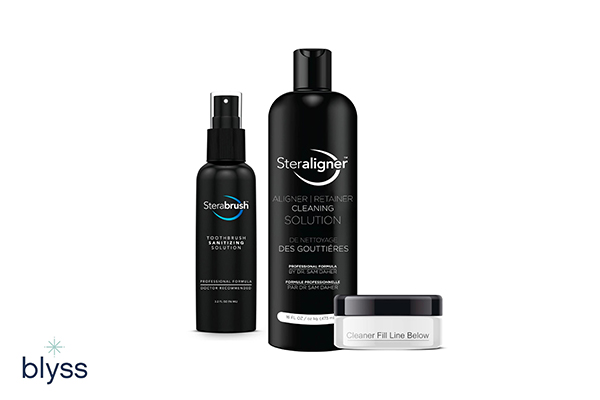
The Steraligner quickly and easily deep cleans your aligner tray in just 3 minutes, preventing the buildup of plaque, tartar, stains, and bad breath.
Simply place your Invisalign aligners in the tray and add the solution. Let them soak for 3 minutes, then rinse them off, and brush them with warm water.
3 – Do Soak Your Aligners in Cleaning Crystals Once A Day
As an Invisalign wearer, you know that it’s important to keep your aligners clean. But did you know that one of the best ways to do that is to soak them in cleaning crystals at least once a day?
Cleaning crystals have a number of benefits when it comes to keeping your Invisalign aligners clean.
- They are extremely effective at removing plaque and bacteria from your aligners. Plaque and bacteria can cause bad breath, and they can also lead to gum disease if they are not removed.
- Cleaning crystals will help to keep your aligners looking clear and new. When plaque and bacteria build up on your aligners, they can cause them to become dull and yellowed. By soaking them in cleaning crystals, you can help to keep them looking like new.
- Cleaning crystals can help to extend the life of your Invisalign aligners. Plaque and bacteria can cause your aligners to break down over time. By soaking them in cleaning crystals, you can help to prevent this from happening.
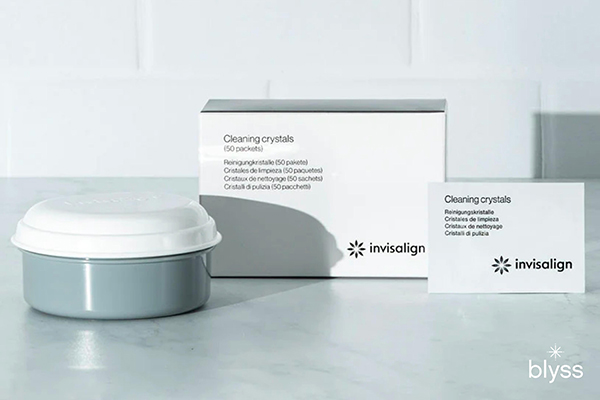
The Invisalign cleaning system includes 1 cleaning tub and 50 packets of cleaning crystals designed to clean and remove plaque from orthodontic aligners and clear retainers in as little as 15 minutes. It keeps your trays odor-free, hygienic, and clear.
I recommend soaking them for at least 15 minutes but feel free to leave them in for longer if you’d like. Be sure to rinse them thoroughly before putting them back in your mouth.
You can find cleaning crystals at most drugstores or online. Be sure to follow the instructions on the packaging carefully in order to ensure that your aligners come out clean and sparkling.
4 – Do Create an Oral Hygiene Routine
When you wear Invisalign clear aligners, it’s more important than ever to maintain good oral hygiene in order to keep your aligners clean and prevent the buildup of bacteria.
The Consequences of Poor Oral Hygiene When Wearing Invisalign
While Invisalign is practically invisible, the aligners still need to be removed for eating and drinking. This means that there is a greater chance for food and bacteria to build up on the aligners themselves as well as on your teeth. If not cleaned properly, this can lead to gum disease, tooth decay, and other oral health problems.
Another consequence of poor oral hygiene when wearing Invisalign is bad breath. Because the aligners need to be removed for eating and drinking, there is also a greater chance for food particles to become trapped between the aligners and your teeth. If these particles are not removed, they will begin to rot and cause an unpleasant smell.
In extreme cases, poorly maintained oral hygiene while wearing Invisalign can result in permanent damage to your teeth. If plaque and tartar are allowed to build up on your teeth, they will begin to erode the enamel. Once the enamel has been damaged, it cannot be repaired; it can only be replaced through costly dental procedures such as veneers or crowns.
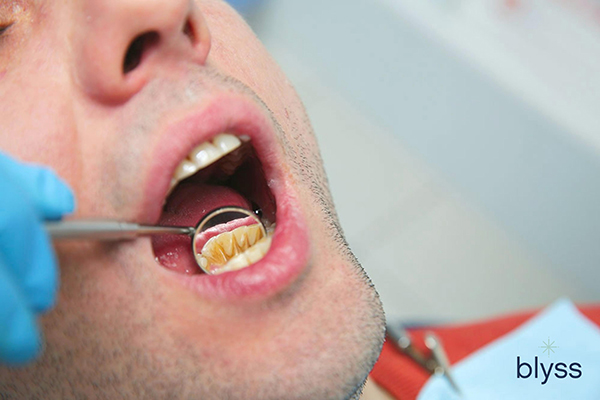
Although Invisalign cannot cause cavities, wearing trays can trap plaque against teeth for lengthy periods if not cleaned properly. Also, if you wear dirty Invisalign aligners, it increases gum tissue irritation and provides an opportunity for gingivitis or gum disease to develop.
5 Tips For Maintaining Good Oral Hygiene While Wearing Invisalign
By following these tips, you can help ensure that your aligners stay clean and clear throughout your treatment.
- Brush and floss your teeth at least twice a day, including before you put your aligners back in after eating or drinking.
- Rinse with mouthwash to help remove any remaining bacteria or food particles.
- Soak your aligners in cleaning crystals or use the Steraligner at least once a day to remove plaque and bacteria from the aligners themselves.
- Don’t eat or drink anything besides water while wearing your aligners, as this will greatly reduce the chances of buildup on both your teeth and the aligners themselves
- See your Invisalign dentist regularly for cleanings and check-ups to ensure that your oral hygiene is on track and to prevent any potential problems.
5 – Do Plan Accordingly For Long Trips For Your Invisalign Cleaning Needs
If you plan on taking a long trip, it’s important to make sure that you have the necessary equipment and supplies to clean your Invisalign aligners.
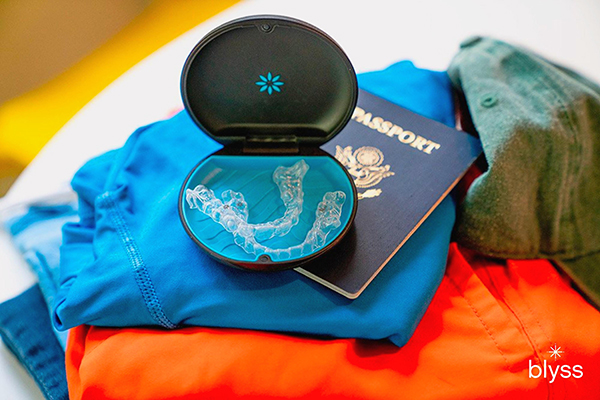
Any time you’re traveling with Invisalign aligners, it’s critical that you maintain the same dental hygiene habits. Packing your Invisalign essentials in advance will help reduce any stress before your trip.
The good news is that with a little bit of planning, you can easily maintain your oral health while on the go. Here are a few things to keep in mind when packing for your next trip:
Bring Extra Aligners: It’s always a good idea to bring along a few extra sets of aligners in case you lose one or they get damaged while you’re away from home. That way, you won’t have to worry about interrupting your treatment or dealing with uncomfortable gaps in your smile.
Pack Your Retainer Case: You’ll need to bring along your retainer case so that you can store your aligners when you’re not wearing them. Be sure to pack it in a place where it won’t get lost or forgotten, such as in your carry-on bag.
Bring Dental Wipes: Dental wipes are great for cleaning your aligners on the go. They can help remove food particles and plaque from your aligners, keeping them clean and fresh. Be sure to pack a few wipes in your purse or bag so that you can use them whenever needed.
See Your Dentist Before You Go: If you’re planning a long trip, it’s a good idea to schedule an appointment with your dentist before you leave. That way, they can perform a thorough cleaning of your teeth and check for any potential problems that could arise while you’re away from home.
Following these tips will help ensure that you have a pleasant and enjoyable vacation—and most importantly, that you come back home with healthy teeth!
5 Don’ts When Cleaning Your Invisalign
Here are five things I recommend you should never do when cleaning your Invisalign.
1 – Don’t Eat or Drink with Your Aligners
One of the things that you need to be careful with is eating and drinking with your Invisalign aligners. It is very tempting to just pop your aligners out whenever you want to have a snack or drink, but this can actually cause some problems.
Risks of Eating with Invisalign Aligners
When it comes to eating, there are a few things you should keep in mind in order to protect your aligners and ensure that your treatment stays on track.
Hard Foods Can Damage Your Aligners
One of the most common ways that people damage their Invisalign aligners is by eating hard foods. Hard candy, nuts, and popcorn kernels can all cause chips and cracks in your aligners. If you do enjoy these types of foods, be sure to remove your aligners first and brush your teeth thoroughly before putting them back in.
Sticky Foods Can Loosen Your Aligners
Another risk associated with eating while wearing Invisalign aligners is sticky foods. Sticky foods such as caramel and gum can cause your aligners to become loose and even fall out. If you must eat sticky foods, be sure to remove your aligners first and brush your teeth thoroughly before putting them back in.
Acidic Foods Can Erode Your Aligners
Acidic fruits such as lemons and oranges can cause irreversible damage to your Invisalign aligners. The acid in these fruits can break down the plastic material of the aligner, causing it to become brittle and weak. If you enjoy these types of fruits, be sure to remove your aligners first or brush your teeth thoroughly before putting them back in.
Risks of Drinking with Invisalign Aligners
While you can drink water with your aligners on, drinking other beverages such as sugary drinks, alcohol, or your favorite cup of coffee or coffee can cause some issues.
Sugary Drinks Can Cause Plaque Buildup and Erosion
Sugary drinks like soda or juice can contribute to the buildup of bacteria and plaque on your aligners. This can lead to bad breath, plaque buildup, and an increased risk of tooth decay. It can also contribute to the erosion of the plastic material, causing it to become weak and potentially break. As with sugary foods, if you do enjoy sugary drinks, be sure to remove your aligners first or brush your teeth thoroughly before putting them back in.
Hot Beverages Can Warp Your Aligners
Hot beverages such as coffee or tea can also cause problems for Invisalign aligners. The heat from these drinks can actually warp the plastic material, causing it to not fit properly on your teeth. If you enjoy hot beverages, let them cool down before drinking with your aligners on, or remove your aligners and brush your teeth before putting them back in.
Alcohol Can Stain and Dry Out Your Aligners
Drinking alcohol can also cause dehydration, which is bad for your teeth and gums. When your mouth is dry, it’s more susceptible to gum disease and cavities. Plus, if you’re a fan of red wines, you might want to cut back on how many glasses you plan on drinking as this cause staining on your teeth. If you plan on enjoying alcoholic beverages, be sure to remove your aligners first and brush your teeth thoroughly before putting them back in.
2 – Don’t Use Abrasive Cleaners that May Damage Your Aligners
Wearing aligners is a big investment, and it’s important to do everything you can to protect that investment.
That’s why it’s important to remember that Invisalign aligners and retainers are made of a plastic material and should be treated with care. Avoid using abrasive cleaners as these can damage the plastic material and potentially cause cracks or breakage.
What should you NOT use to clean your Invisalign?
- Harsh Chemicals: Avoid using harsh chemicals, such as bleach, baking soda, or alcohol, to clean your aligners. These can damage the material and cause them to break down prematurely. Stick to gentle soap and water instead.
- Abrasive Materials: Don’t use anything abrasive to clean your aligners, as this can scratch the surface and dull the finish. This includes materials like toothpaste with gritty particles or a toothbrush with hard bristles. Stick to soft bristles and mild soap to avoid damaging your aligners.
- Hot Water: Avoid using hot water to clean your aligners, as this can cause them to warp. Stick to lukewarm water instead so that you don’t damage your aligners.
- Bleach: This one should be a no-brainer, but bleach is far too harsh for your Invisalign and will cause damage if used regularly. Avoid using bleach or any other cleaning products that contain bleach.
- Cleansing Soaps with Added Dyes: Invisalign recommends using a mild, non-whitening soap to clean your aligners. Soaps with added dyes can stain the plastic material and create discoloration on your aligners. Stick to clear, mild soaps for cleaning.
3 – Don’t Leave Your Aligners and Trays Out in the Open
It’s important to keep your aligners and trays clean, but it’s also important to remember to store them properly.
Leaving your Invisalign aligners exposed to the air can cause them to dry out and become brittle. When this happens, they are more susceptible to cracking and breaking. And if your aligners do break, you’ll have to replace them, which can be costly and delay your treatment.
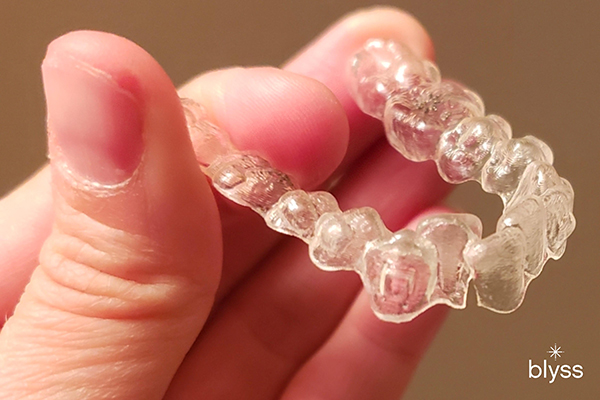
It is important that you ensure that your Invisalign trays are dry and not wet before storing them in your case to prevent mold formation.
In addition to drying out, Invisalign trays can also pick up dust, dirt, and other debris when left out in the open. Not only is this unsightly, but it can also lead to infection if the aligners are not cleaned properly before being inserted into your mouth.
Finally, leaving your Invisalign aligners out in the open is just asking for them to get lost. I can’t tell you how many times I’ve seen patients come into our office panicking because they can’t find their Invisalign tray. Avoid this stressful situation by keeping your aligners in their case when they’re not in use.
As an Invisalign patient, it’s important to take good care of your aligners to ensure that they last throughout your treatment. This means keeping them clean and stored away safely when you’re not wearing them. So next time you’re tempted to leave your Invisalign tray out on the counter or coffee table, resist the urge and put it back in its case where it belongs. Trust me, your aligners (and wallet) will thank you!
Related Article: Invisalign Cost Insider Tips: How to Save Thousands of Dollars on Your Invisalign Treatment
4 – Don’t Forget to Clean Your Aligner Case
Your Invisalign case is just as important as your aligners when it comes to keeping your teeth and mouth clean.
Why You Should Clean Your Aligner Case
Your aligners are meant to be worn for about 22 hours a day, which means they’re constantly in contact with your saliva. Since saliva contains bacteria, it’s not surprising that your aligners can start to harbor bacteria over time. If you don’t clean your aligner case regularly, that bacteria can transfer back to your aligners and cause them to become discolored or odorous.
In addition to being unsightly and smelly, the build-up of bacteria on your aligners can also lead to gum disease and other oral health problems. That’s why it’s so important to keep your aligner case clean. A dirty aligner case can negate the benefits of wearing Invisalign in the first place.
Additionally, mold can also grow in a dirty aligner case if it’s not dried properly before storage.
How to Clean Your Aligner Case
The best way to clean your aligner case is with warm water and anti-bacterial soap. Simply rinse out your case with warm water and then add a drop or two of soap. Swish the soap around until it forms a lather and then rinses thoroughly. Be sure to dry your case completely before putting your aligners back in. And remember, never put your aligners back into the case until it is fully dry to prevent mold growth.
It’s also a good idea to sanitize your case every week. This will kill any bacteria that may be lurking inside. Just be sure to let it cool completely before adding and storing your aligners. It’s best to do this at least once a day, but more often is even better.
5 – Don’t Smoke (or at least try to avoid it)
We all know how bad smoking is for our health, and the same holds true for Invisalign wearers.
Smoking is one of the worst things you can do for your oral health. It not only increases your risk of developing gum disease, but it can also lead to tooth loss. And if that’s not enough, smoking also stains teeth and leaves behind a nasty smell. When you wear Invisalign aligners, all of these effects are magnified. Here’s why.
Smoking Can Stain Your Aligners
If you smoke while you’re wearing Invisalign aligners, the nicotine and tar in cigarettes can cause them to become stained. Even if you don’t smoke yourself, being around others who do can cause your aligners to become discolored. And because the whole point of Invisalign is to have clear aligners that are virtually invisible, stained aligners can be a major setback. If your aligners do become stained, don’t despair—simply brush them with toothpaste and rinse them well with water. You can also soak them in denture cleaner overnight to help remove tough stains.
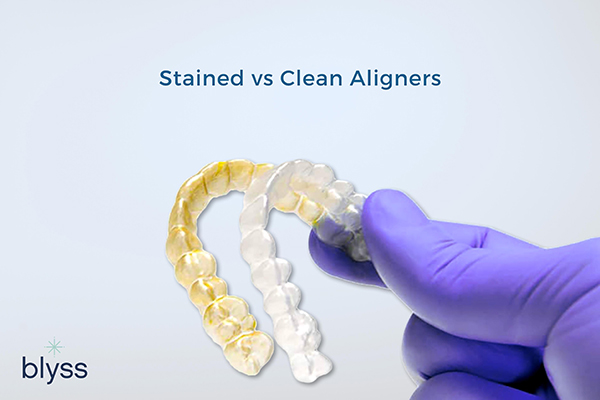
If you smoke while wearing aligners, nicotine and tar can quickly discolor the clear trays. Even if you remove the trays when smoking, the residue from nicotine and tar can still linger in your mouth and cause stains.
Smoking Can Cause Gum Disease
Smoking is also one of the leading causes of gum disease. Gum disease is an infection of the gums that can cause inflammation, bleeding, and eventually tooth loss. If you have gum disease, it’s important to get it treated by a dentist as soon as possible. Gum disease can not only jeopardize your Invisalign treatment, but it can also lead to serious health complications if left untreated. So if you smoke and are wearing Invisalign aligners, be sure to visit your dentist regularly for checkups and cleanings so that any signs of gum disease can be caught early and treated accordingly.
Smoking Can Delay Your Treatment
Finally, smoking can delay your Invisalign treatment. Because tobacco use impedes the body’s ability to heal, people who smoke often take longer to recover from dental procedures than those who don’t smoke. This means that if you have any oral surgery or other dental procedures while you’re wearing Invisalign aligners, it’s likely that your recovery time will be longer than average—which could ultimately delay the completion of your treatment. So if you want to avoid delays, it’s best to quit smoking before starting Invisalign (or at least cut back as much as possible).
If you want to get the most out of your Invisalign treatment, it’s best to avoid smoking altogether. However, I understand that quitting smoking is easier said than done. If you cannot quit, at least try to limit your smoking as much as possible and brush your teeth and aligners thoroughly after each cigarette.
The Takeaway
Cleaning your Invisalign aligners and case regularly is important for maintaining good oral hygiene. Invisalign is a great way to straighten teeth without the use of traditional braces. However, also essential to know the dos and don’ts of cleaning Invisalign so you can keep them in great condition and achieve the best results from your treatment.
At Blyss Dental, we specialize in Invisalign and can customize a treatment plan for you. Contact us today to schedule a free consultation and learn more about how we can help you achieve the smile of your dreams.
9 Sources Cited From
- Levrini L, Novara F, Margherini S, Tenconi C, Raspanti M. Scanning electron microscopy analysis of the growth of dental plaque on the surfaces of removable orthodontic aligners after the use of different cleaning methods. Clin Cosmet Investig Dent. 2015 Dec 15;7:125-31. doi: 10.2147/CCIDE.S95814. PMID: 26719726; PMCID: PMC4687621.
- Piedade, L. (2016). Invisalign: What You Need to Know (First Edition). Lulu.com
- Orthodontic Treatment with Clear Aligners. (2021, June 17). American Association of Orthodontists. https://www.aaoinfo.org/blog/orthodontic-treatment-with-clear-aligners/
- Frequently Asked Questions | Invisalign. (n.d.). Retrieved October 28, 2022, from https://www.invisalign.com/frequently-asked-questions
- Levrini, L., Mangano, A., Montanari, P., Margherini, S., Caprioglio, A., & Abbate, G. M. (2015). Periodontal health status in patients treated with the Invisalign® system and fixed orthodontic appliances: A 3 months clinical and microbiological evaluation. European Journal of Dentistry, 9(3), 404-410. https://doi.org/10.4103/1305-7456.163218
- Wible, E., Agarwal, M., Altun, S., Ramir, T., Viana, G., Evans, C., Lukic, H., Megremis, S., & Atsawasuwan, P. (2019). Long-term effects of various cleaning methods on polypropylene/ethylene copolymer retainer material. The Angle Orthodontist, 89(3), 432-437. https://doi.org/10.2319/060818-429.1
- Seleem, D.; Dadjoo, S.; Ha, A.; Santos, C.; Mirfarsi, S.; Matsumura-Lem, K.; Lazarchik, D. Effect of 10% Carbamide Peroxide on Tooth Shade, Plaque Index and Gingival Index during Invisalign Treatment. Dent. J. 2021, 9, 48. https://doi.org/10.3390/dj9050048
- Kiatwarawut, K.; Rokaya, D.; Sirisoontorn, I. Antimicrobial Activity of Various Disinfectants to Clean Thermoplastic Polymeric Appliances in Orthodontics. Polymers 2022, 14, 2256. https://doi.org/10.3390/polym14112256
- Jashinsky, J. M., Liles, S., Schmitz, K., Ding, D., & Hovell, M. (2017). Risk Factors for Tobacco Susceptibility in an Orthodontic Population: An Exploratory Study. American journal of orthodontics and dentofacial orthopedics: official publication of the American Association of Orthodontists, its constituent societies, and the American Board of Orthodontics, 152(2), 171. https://doi.org/10.1016/j.ajodo.2016.12.016
